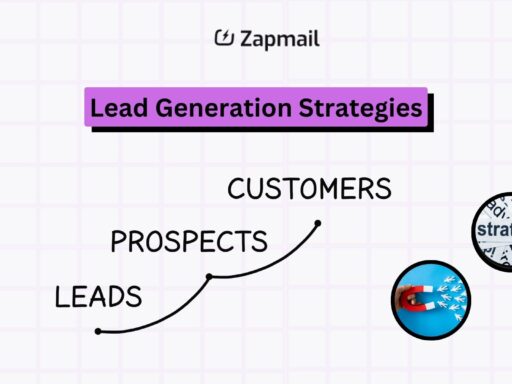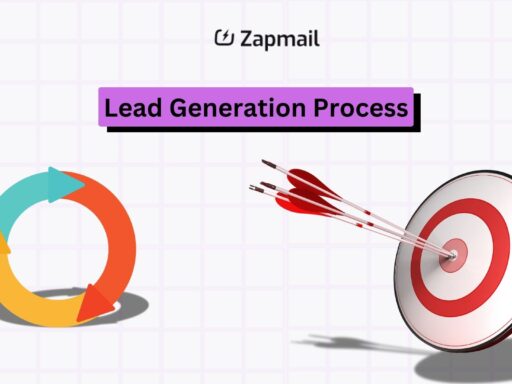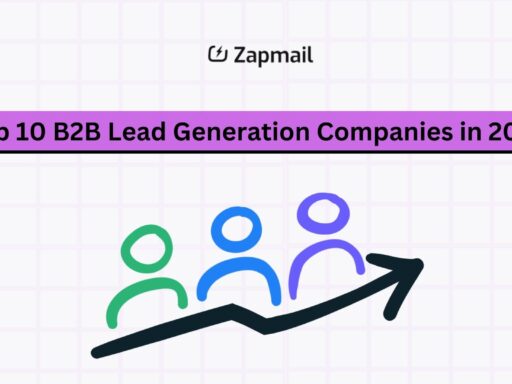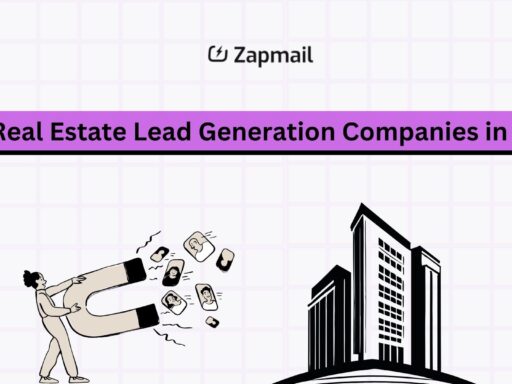In B2B marketing, it’s surprising that only 1% of website visitors typically convert into qualified leads. These leads are crucial for any B2B company’s success. This guide will show you how to generate B2B leads effectively. You’ll learn how to attract, engage, and convert leads that boost your revenue.
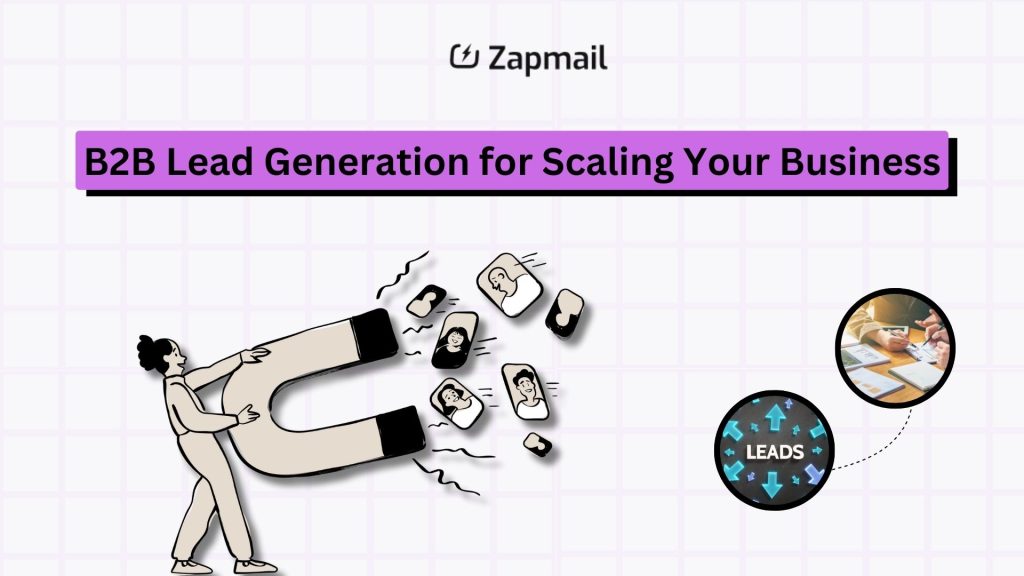
This guide is for both experienced marketers and new entrepreneurs. It offers proven strategies, insightful tactics, and the latest techniques for a successful B2B lead generation plan. You’ll learn about content marketing, email campaigns, social media, and website optimization. These are key to growing your business and beating your rivals.
Key Takeaways
- Learn the main differences between B2B and B2C lead generation strategies
- Find out how to identify your target audience and create buyer personas
- Discover various effective B2B lead generation channels to enhance your efforts
- Use content marketing and cold email outreach to nurture and convert leads into customers
- Track and analyze your B2B lead generation performance to keep improving
What is B2B Lead Generation?
B2B lead generation is about finding and helping potential business customers. It’s different from B2C, which targets individual shoppers. B2B helps businesses grow by finding new clients and partners.
Understanding the Importance of Lead Generation
Lead generation is key for B2B marketing success. It helps find and engage potential customers. This way, you can turn leads into sales and grow your business.
The Difference Between B2B and B2C Lead Generation
B2B and B2C lead generation have different goals and methods. B2B deals with longer sales and complex business decisions. B2C focuses on quick sales and emotional appeals.
Knowing B2B lead generation’s unique aspects is vital. It helps create strategies that meet your audience’s needs and boost your business.
Building a Strong B2B Lead Generation Strategy
Creating a solid B2B lead generation strategy is key to growing your business. It starts with knowing who your target audience is and making detailed buyer personas. This way, you can meet your potential customers’ needs and engage them effectively.
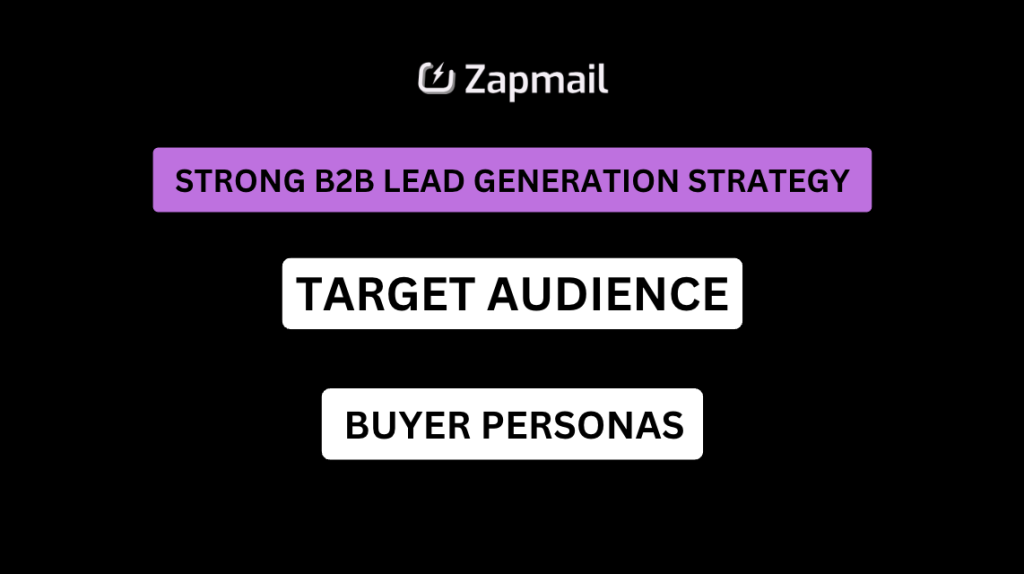
Identifying Your Target Audience
Start by clearly defining your target audience. Research your industry, competitors, and customers to find key decision-makers. Look at company size, industry, job roles, and pain points to create a detailed profile of your ideal customer.
Developing Buyer Personas
After understanding your target audience, create detailed buyer personas. These should be based on real data and insights. Collect information on demographics, goals, challenges, and buying behaviors. Use this data to guide your B2B lead generation strategy and inform your marketing and sales efforts.
- Conduct market research to understand your target audience’s pain points and purchase drivers
- Gather data on your existing customers to identify common characteristics and behaviors
- Create detailed buyer personas that include demographics, goals, challenges, and buying patterns
- Regularly update your buyer personas as your business and market evolve
By focusing on identifying your target audience and developing comprehensive buyer personas, you can create a B2B lead generation strategy that resonates with the right decision-makers and drives sustainable business growth.
Effective B2B Lead Generation Channels
Getting high-quality B2B leads is key to growing your business. There are many good ways to get leads and turn them into customers.
Content marketing is a strong way to get leads. By making useful content, you show you know your stuff. This attracts people looking for answers. You can use blog posts, white papers, and webinars to do this.
Cold email outreach is also great for getting leads. Build a list of people you want to reach and send them messages that matter. Using automation and personal touches makes it even better.
Social media, especially LinkedIn, is useful too. It lets you connect with people in your field. You can share interesting stuff and find your perfect customers.
Other ways to get leads include:
- Networking and going to events
- Working with partners
- Referral programs
- Improving your website’s search ranking
To get the best leads, try different methods. See what works and keep improving. Find the best mix for your business.
Content Marketing for B2B Lead Generation
In the B2B world, content marketing is a key tool for grabbing your audience’s attention. By making valuable, informative, and engaging content, you can show your brand is trustworthy. You become a go-to resource in your field.
Creating Valuable Content
To succeed in B2B content marketing, focus on making content that really helps your audience. This could be detailed industry reports, educational blog posts, webinars, or interactive tools. The aim is to give your audience content that solves their problems and meets their needs.
Repurposing Content for Maximum Reach
- Make your content work harder by using it in different ways. For example, turn a long blog post into social media posts, a podcast, or a video.
- Using B2B Lead Generation Content Marketing and Content Repurposing helps you reach more people. It ensures your message gets to your target prospects.
- By Content Creation and repurposing, you boost your B2B lead generation efforts. This drives more qualified leads to your business.
Cold Email Outreach: A Powerful B2B Lead Generation Tool
Cold email outreach is a key tool in B2B lead generation. It uses email automation and personalization to turn leads into loyal customers. This approach is both powerful and versatile.
Email Automation and Personalization
Email automation helps businesses by creating custom email campaigns. These campaigns meet the specific needs of their audience. It ensures that leads get the right message at the right time, boosting engagement and conversions.
Personalization elevates cold emailing by making content specific to each recipient. Using names, job titles, or industries makes messages more compelling. This approach increases the chance of a positive response from leads.
- Leverage email automation to nurture your B2B leads with timely, personalized messages.
- Personalize email content, subject lines, and messaging to resonate with your target audience.
- Combine email automation and personalization to create a seamless and engaging lead generation experience.
Mastering B2B lead generation cold emailing helps businesses build strong relationships. It establishes trust and converts leads into valuable customers. Stay tuned for more strategies to improve your B2B lead generation efforts.
B2B Lead Generation
Getting high-quality leads is crucial for any B2B business to thrive. The lead generation process involves several steps. These range from attracting leads to turning them into loyal customers. By using the right tactics, you can grow your B2B business and achieve lasting success.
The main stages of the B2B lead generation process are:
- Attracting Leads: This means creating valuable content and optimizing your website. You also use different marketing channels to grab your target audience’s attention.
- Qualifying Leads: You carefully check each lead’s potential. This ensures they fit your ideal customer profile and are likely to become paying customers.
- Nurturing Leads: You engage with your leads through personalized messages and educational content. This builds trust and moves them closer to buying.
- Converting Leads: You use effective sales strategies and closing techniques. This turns qualified leads into paying customers and brand advocates.
Mastering the B2B lead generation process helps you get a steady flow of quality leads. This fuels your business growth. Remember, successful lead generation needs a strategic and data-driven approach. It also requires understanding your target audience and their needs.
Social Media for B2B Lead Generation
In today’s digital world, social media is key for B2B lead generation. It helps you reach your target audience, show your expertise, and get quality leads. This is crucial for your business’s growth.
Leveraging LinkedIn for B2B Leads
LinkedIn is the top choice for B2B professionals. Being active on LinkedIn lets you share your knowledge, connect with others, and find new leads. Here are some ways to use LinkedIn for B2B lead generation:
- Optimize your LinkedIn profile: Make sure your profile is complete and shows your industry skills and leadership.
- Participate in relevant LinkedIn groups: Join and contribute to groups related to your industry. This helps you connect with your audience and show your expertise.
- Leverage LinkedIn’s advertising tools: Use LinkedIn’s ads to target your ideal customers and get quality leads.
- Engage with your connections: Interact with your LinkedIn connections by commenting, sharing, and building strong relationships.
By using these LinkedIn strategies, you can boost your B2B lead generation. This way, you can attract and connect with potential customers through social media.
Optimizing Your Website for B2B Lead Generation
Your website is key in B2B lead generation. It attracts and converts potential customers. By optimizing it, you boost your online presence and user experience. This leads to more qualified leads for your business.
Lead capture forms are vital for website optimization. Place them strategically on your site. This makes it simple for visitors to show interest and share their contact info. Make sure the forms are easy to use and encourage visitors to interact with your business.
Creating valuable content is also crucial. It makes your business a thought leader in your field. Use blog posts, whitepapers, or webinars to address your audience’s needs and interests.
Improving your website’s user experience is also important. Make it visually appealing, easy to navigate, and mobile-friendly. A good user experience keeps visitors interested and encourages them to become leads.
By focusing on these key areas, you can attract, engage, and convert your target audience. This drives growth and success for your business.
Lead Nurturing: Turning Leads into Customers
In B2B marketing, getting leads is just the start. The real task is to nurture those leads into loyal, paying customers. This is where B2B lead nurturing comes in.
Developing a Lead Nurturing Funnel
A well-designed lead nurturing funnel is key to B2B success. It guides leads from awareness to conversion. With a good funnel, you can build strong relationships and lead prospects to purchase.
The main parts of a strong B2B lead nurturing funnel include:
- Lead capture: Offering valuable content to grab your audience’s attention and turn them into leads.
- Lead segmentation: Grouping leads based on their behavior and interests, for personalized nurturing.
- Automated email campaigns: Sending personalized emails to keep leads engaged and moving towards conversion.
- Lead scoring: Scoring leads based on their engagement, to focus on the most promising ones.
- Sales handoff: Transferring qualified leads to your sales team for a smooth conversion process.
With a comprehensive B2B lead nurturing funnel, you can turn leads into loyal customers. This drives sustainable growth for your business.
Measuring and Analyzing Your B2B Lead Generation Efforts
Effective B2B lead generation is more than just attracting potential customers. It’s also about measuring and analyzing your efforts for long-term success. By tracking key metrics and using data-driven insights, you can improve your B2B lead generation strategies. This way, you can get the most out of your investment.
When it comes to B2B Lead Generation Measurement, there are several important metrics to track:
- Lead volume: The total number of leads generated through your various marketing channels.
- Lead conversion rate: The percentage of leads that convert into qualified sales opportunities.
- Cost per lead: The average cost associated with generating each lead.
- Return on investment (ROI): The financial return you’re getting from your lead generation efforts.
By analyzing these Lead Generation Analytics, you can see which channels and tactics work best. You can also find areas for improvement and better budget allocation. This data-driven approach helps you refine your B2B lead generation strategy. It drives better results over time.
Remember, measuring and analyzing your B2B lead generation efforts is not a one-time task. It’s an ongoing process. Regularly reviewing your metrics and making data-informed decisions keeps you ahead of the competition. It helps your business grow sustainably.
Outsourcing B2B Lead Generation
In the fast-paced world of B2B marketing, getting quality leads can take a lot of time and effort. But, outsourcing your lead generation can open up many benefits for your business.
Working with specialized lead generation services gives you access to a lot of expertise and tools. These experts can handle the complex world of B2B lead generation. This lets your team focus on other important parts of your business.
When you think about outsourcing lead generation, there are many advantages:
- Access to a larger talent pool and specialized expertise
- Scalability in lead generation efforts to meet fluctuating demand
- Reduced overhead costs and operational expenses
- Improved data-driven insights and performance optimization
- Seamless integration with your existing marketing and sales processes
To make a successful partnership, it’s important to carefully choose a service provider. You should also set clear goals and KPIs. And, keep communication open throughout the partnership. By using Outsourcing B2B Lead Generation, you can make your lead generation more efficient. This can help you get more qualified leads and grow your business faster.
Best Practices for B2B Lead Generation
Successful B2B lead generation needs a strategic plan that values quality over quantity. By following these best practices, you can improve your lead generation efforts. This will help your business grow in meaningful ways.
- Prioritize Data and Analytics: Use data and analytics to learn about your target audience. Understand their pain points and tailor your outreach. This will help refine your B2B lead generation strategies.
- Personalize Your Outreach: Personalization is crucial in B2B. Create personalized messages, content, and offers that speak to your prospects. Show them you understand their unique needs.
- Focus on Quality Leads: Aim for a smaller number of high-quality leads rather than many low-quality ones. Quality should be your main focus.
- Continuously Optimize: Always review and improve your B2B lead generation strategies based on data. Try new tactics, measure their success, and adjust to keep improving.
By following these best practices, you can create a steady flow of qualified leads. This will help your business grow in the long term.
Affordable Email Infrastructure for B2B Businesses
For B2B companies, establishing a reliable email infrastructure is crucial for successful outreach and lead generation.
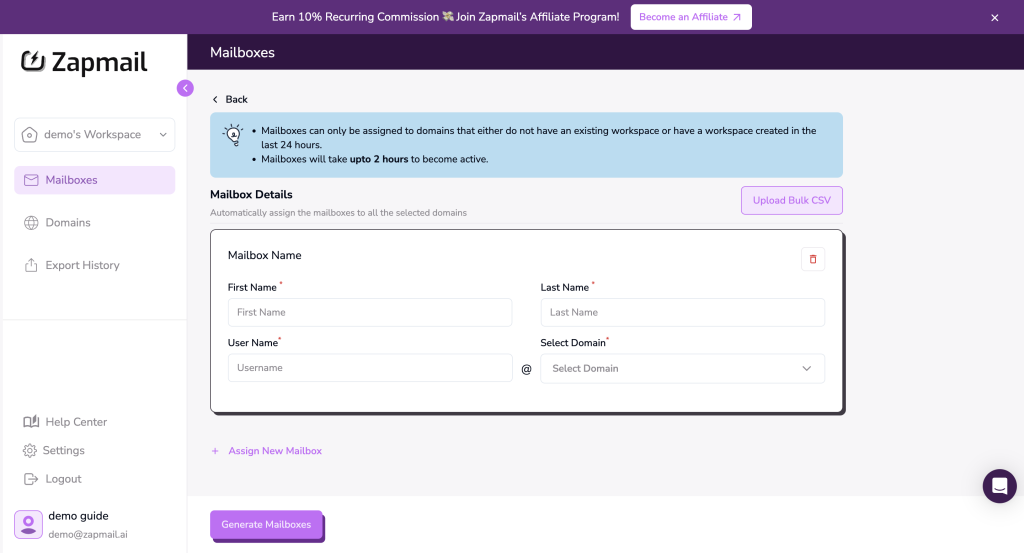
However, setting up and maintaining email systems that ensure high deliverability, compliance, and scalability can be expensive and complex without the right tools. Zapmail is a solution that streamlines this process by providing cost-effective, efficient email infrastructure that caters specifically to the needs of B2B businesses.
With Zapmail, companies can set up and manage multiple mailboxes, ensuring seamless domain and email account setup with essential features like SPF, DKIM and DMARC records to boost deliverability.
By simplifying tasks like domain management and mailbox exports, Zapmail reduces the technical barriers typically associated with B2B email infrastructure. This allows businesses to focus on creating meaningful connections rather than managing email logistics.
Conclusion
B2B lead generation is key for growing your business and increasing revenue. It helps you find and attract high-quality leads. These leads are more likely to become loyal customers.
This guide has shown you how to use content marketing, email automation, and social media. It also talked about optimizing your website. You now have the tools to create a strong lead generation plan.
Remember, it’s important to keep track of your results. This helps you improve your lead generation efforts. Stay focused on providing value and adapting to your market’s needs.
By following the best practices in this guide, you can set your business up for success. You’ll be able to grow faster in the competitive B2B world.
FAQ
B2B lead generation is about finding and helping potential customers for businesses that sell to other companies. It uses marketing strategies to find and talk to people or companies that might need what you offer.
It’s key for growing a business and making more money. By getting good leads, companies can have more chances to sell and grow over time.
B2B focuses on business-to-business, with longer sales cycles and more complex strategies. B2C is about selling to consumers, with quicker sales and simpler tactics.
First, find out who your ideal customer is. Look at demographics, industry trends, and create buyer personas. This helps you know who to target.
Top channels include content marketing, email, social media (like LinkedIn), SEO, and networking. Choose the best ones for your audience and goals.
Content marketing is great for attracting leads. Create valuable content that solves problems for your audience. Use a content calendar and lead forms to capture interest.
Social media, especially LinkedIn, is powerful. Use it to connect, share content, and build your brand. This attracts and engages quality leads.
Lead nurturing guides leads through the sales process. It builds relationships and converts them into customers. Use valuable content and personalized interactions to move leads forward.
Track important metrics like lead volume, conversion rates, and return on investment. This helps you see what’s working and make improvements.
Outsourcing is good when you need more expertise or want to scale fast. But, choose the right partner and keep an eye on the work for success.
